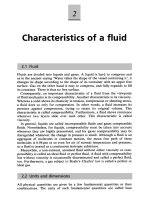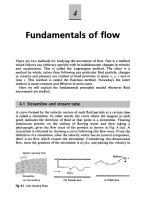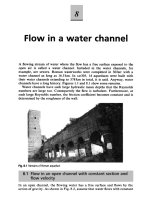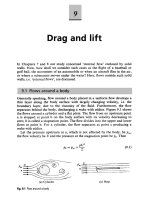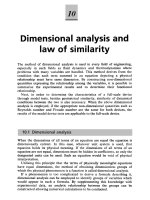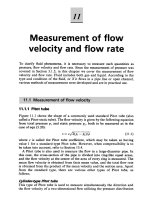- Trang chủ >>
- Khoa Học Tự Nhiên >>
- Vật lý
Mechanics kleppner 2ed (2)
Bạn đang xem bản rút gọn của tài liệu. Xem và tải ngay bản đầy đủ của tài liệu tại đây (4.59 MB, 564 trang )
www.pdfgrip.com
An Introduction to Mechanics
For 40 years, Kleppner and Kolenkow’s classic text has introduced students to the principles of mechanics. Now brought up-to-date, this revised and improved Second Edition is ideal for classical mechanics
courses for first- and second-year undergraduates with foundation skills
in mathematics.
The book retains all the features of the first edition, including numerous worked examples, challenging problems, and extensive illustrations,
and has been restructured to improve the flow of ideas. It now features
• New examples taken from recent developments, such as laser slowing
of atoms, exoplanets, and black holes
• A “Hints, Clues, and Answers” section for the end-of-chapter problems to support student learning
• A solutions manual for instructors at www.cambridge.org/kandk
d a n i e l k l e p p n e r is Lester Wolfe Professor of Physics, Emeritus, at
Massachusetts Institute of Technology. For his contributions to teaching
he has been awarded the Oersted Medal by the American Association
of Physics Teachers and the Lilienfeld Prize of the American Physical
Society. He has also received the Wolf Prize in Physics and the National
Medal of Science.
r o b e r t k o l e n k o w was Associate Professor of Physics at Massachusetts Institute of Technology. Renowned for his skills as a teacher,
Kolenkow was awarded the Everett Moore Baker Award for Outstanding
Teaching.
Daniel Kleppner
Robert Kolenkow
AN
INTRODUCTION
TO
MECHANICS
SECOND EDITION
University Printing House, Cambridge CB2 8BS, United Kingdom
Cambridge University Press is a part of the University of Cambridge.
It furthers the University’s mission by disseminating knowledge in the pursuit of
education, learning and research at the highest international levels of excellence.
www.cambridge.org
Information on this title: www.cambridge.org/9780521198110
c D. Kleppner and R. Kolenkow 2014
This edition is not for sale in India.
This publication is in copyright. Subject to statutory exception
and to the provisions of relevant collective licensing agreements,
no reproduction of any part may take place without the written
permission of Cambridge University Press.
First edition previously published by McGraw-Hill Education 1973
First published by Cambridge University Press 2010
Reprinted 2012
Second edition published by Cambridge University Press 2014
Printed in the United States by Sheridan Inc.
A catalogue record for this publication is available from the British Library
ISBN 978-0-521-19811-0 Hardback
Additional resources for this publication at www.cambridge.org/kandk
Cambridge University Press has no responsibility for the persistence or accuracy of
URLs for external or third-party internet websites referred to in this publication,
and does not guarantee that any content on such websites is, or will remain,
accurate or appropriate.
CONTENTS
PREFACE
TO THE TEACHER
LIST OF EXAMPLES
1
VECTORS AND KINEMATICS
1.1
Introduction
1.2
Vectors
1.3
The Algebra of Vectors
1.4
Multiplying Vectors
1.5
Components of a Vector
1.6
Base Vectors
1.7
The Position Vector r and Displacement
1.8
Velocity and Acceleration
1.9
Formal Solution of Kinematical Equations
1.10 More about the Time Derivative of a Vector
1.11 Motion in Plane Polar Coordinates
Note 1.1 Approximation Methods
Note 1.2 The Taylor Series
Note 1.3 Series Expansions of Some Common
Functions
Note 1.4 Differentials
Note 1.5 Significant Figures and Experimental
Uncertainty
Problems
page xi
xv
xvii
1
2
2
3
4
8
11
12
14
19
22
26
36
37
38
39
40
41
vi
CONTENTS
2
NEWTON’S LAWS
2.1
Introduction
2.2
Newtonian Mechanics and Modern Physics
2.3
Newton’s Laws
2.4
Newton’s First Law and Inertial Systems
2.5
Newton’s Second Law
2.6
Newton’s Third Law
2.7
Base Units and Physical Standards
2.8
The Algebra of Dimensions
2.9
Applying Newton’s Laws
2.10 Dynamics Using Polar Coordinates
Problems
3
FORCES AND EQUATIONS OF MOTION
3.1
Introduction
3.2
The Fundamental Forces of Physics
3.3
Gravity
3.4
Some Phenomenological Forces
3.5
A Digression on Differential Equations
3.6
Viscosity
3.7
Hooke’s Law and Simple Harmonic Motion
Note 3.1 The Gravitational Force of a Spherical Shell
Problems
81
82
82
83
89
95
98
102
107
110
4
MOMENTUM
4.1
Introduction
4.2
Dynamics of a System of Particles
4.3
Center of Mass
4.4
Center of Mass Coordinates
4.5
Conservation of Momentum
4.6
Impulse and a Restatement of the Momentum
Relation
4.7
Momentum and the Flow of Mass
4.8
Rocket Motion
4.9
Momentum Flow and Force
4.10 Momentum Flux
Note 4.1 Center of Mass of Two- and
Three-dimensional Objects
Problems
115
116
116
119
124
130
5
ENERGY
5.1
Introduction
5.2
Integrating Equations of Motion in One Dimension
5.3
Work and Energy
5.4
The Conservation of Mechanical Energy
5.5
Potential Energy
5.6
What Potential Energy Tells Us about Force
47
48
48
49
51
51
54
59
63
64
72
77
131
136
138
143
145
151
155
161
162
162
166
179
182
185
CONTENTS
vii
5.7
Energy Diagrams
5.8
Non-conservative Forces
5.9
Energy Conservation and the Ideal Gas Law
5.10 Conservation Laws
5.11 World Energy Usage
Note 5.1 Correction to the Period of a Pendulum
Note 5.2 Force, Potential Energy, and the Vector
Operator ∇
Problems
185
187
189
192
194
199
6
TOPICS IN DYNAMICS
6.1
Introduction
6.2
Small Oscillations in a Bound System
6.3
Stability
6.4
Normal Modes
6.5
Collisions and Conservation Laws
Problems
211
212
212
217
219
225
233
7
ANGULAR MOMENTUM AND FIXED AXIS ROTATION
7.1
Introduction
7.2
Angular Momentum of a Particle
7.3
Fixed Axis Rotation
7.4
Torque
7.5
Torque and Angular Momentum
7.6
Dynamics of Fixed Axis Rotation
7.7
Pendulum Motion and Fixed Axis Rotation
7.8
Motion Involving Translation and Rotation
7.9
The Work–Energy Theorem and Rotational
Motion
7.10 The Bohr Atom
Note 7.1 Chasles’ Theorem
Note 7.2 A Summary of the Dynamics of Fixed Axis
Rotation
Problems
239
240
241
245
250
252
260
262
267
8
RIGID BODY MOTION
8.1
Introduction
8.2
The Vector Nature of Angular Velocity and
Angular Momentum
8.3
The Gyroscope
8.4
Examples of Rigid Body Motion
8.5
Conservation of Angular Momentum
8.6
Rigid Body Rotation and the Tensor of Inertia
8.7
Advanced Topics in Rigid Body Dynamics
Note 8.1 Finite and Infinitesimal Rotations
Note 8.2 More about Gyroscopes
Problems
200
205
273
277
280
282
282
291
292
292
300
304
310
312
320
329
331
337
viii
CONTENTS
9
10
11
12
NON-INERTIAL SYSTEMS AND FICTITIOUS FORCES
9.1
Introduction
9.2
Galilean Transformation
9.3
Uniformly Accelerating Systems
9.4
The Principle of Equivalence
9.5
Physics in a Rotating Coordinate System
Note 9.1 The Equivalence Principle and the
Gravitational Red Shift
Problems
341
342
342
344
347
356
CENTRAL FORCE MOTION
10.1 Introduction
10.2 Central Force Motion as a One-body Problem
10.3 Universal Features of Central Force Motion
10.4 The Energy Equation and Energy Diagrams
10.5 Planetary Motion
10.6 Some Concluding Comments on Planetary
Motion
Note 10.1 Integrating the Orbit Integral
Note 10.2 Properties of the Ellipse
Problems
373
374
374
376
379
386
368
370
402
403
405
407
THE HARMONIC OSCILLATOR
11.1 Introduction
11.2 Simple Harmonic Motion: Review
11.3 The Damped Harmonic Oscillator
11.4 The Driven Harmonic Oscillator
11.5 Transient Behavior
11.6 Response in Time and Response in Frequency
Note 11.1 Complex Numbers
Note 11.2 Solving the Equation of Motion for the
Damped Oscillator
Note 11.3 Solving the Equation of Motion for the
Driven Harmonic Oscillator
Problems
411
412
412
414
421
425
427
430
THE SPECIAL THEORY OF RELATIVITY
12.1 Introduction
12.2 The Possibility of Flaws in Newtonian Physics
12.3 The Michelson–Morley Experiment
12.4 The Special Theory of Relativity
12.5 Transformations
12.6 Simultaneity and the Order of Events
12.7 The Lorentz Transformation
12.8 Relativistic Kinematics
12.9 The Relativistic Addition of Velocities
12.10 The Doppler Effect
439
440
440
442
445
447
450
451
454
463
466
431
434
435
CONTENTS
ix
13
14
12.11 The Twin Paradox
Problems
470
472
RELATIVISTIC DYNAMICS
13.1 Introduction
13.2 Relativistic Momentum
13.3 Relativistic Energy
13.4 How Relativistic Energy and Momentum
are Related
13.5 The Photon: A Massless Particle
13.6 How Einstein Derived E = mc2
Problems
477
478
478
481
487
488
498
499
SPACETIME PHYSICS
14.1 Introduction
14.2 Vector Transformations
14.3 World Lines in Spacetime
14.4 An Invariant in Spacetime
14.5 Four-Vectors
14.6 The Energy–Momentum Four-Vector
14.7 Epilogue: General Relativity
Problems
503
504
504
506
508
509
512
513
515
HINTS, CLUES, AND ANSWERS TO SELECTED
PROBLEMS
APPENDIX A MISCELLANEOUS PHYSICAL AND
ASTRONOMICAL DATA
APPENDIX B GREEK ALPHABET
APPENDIX C SI PREFIXES
INDEX
519
527
529
531
533
PREFACE
An Introduction to Mechanics grew out of a one-semester course at the
Massachusetts Institute of Technology—Physics 8.012—intended for
students who seek to understand physics more deeply than the usual
freshman level. In the four decades since this text was written physics
has moved forward on many fronts but mechanics continues to be a
bedrock for concepts such as inertia, momentum, and energy; fluency
in the physicist’s approach to problem-solving—an underlying theme of
this book—remains priceless. The positive comments we have received
over the years from students, some of whom are now well advanced in
their careers, as well as from faculty at M.I.T. and elsewhere, reassures
us that the approach of the text is fundamentally sound. We have received
many suggestions from colleagues and we have taken this opportunity to
incorporate their ideas and to update some of the discussions.
We assume that our readers know enough elementary calculus to differentiate and integrate simple polynomials and trigonometric functions.
We do not assume any familiarity with differential equations. Our experience is that the principal challenge for most students is not with understanding mathematical concepts but in learning how to apply them to
physical problems. This comes with practice and there is no substitute
for solving challenging problems. Consequently problem-solving takes
high priority. We have provided numerous worked examples to help provide guidance. Where possible we try to tie the examples to interesting
physical phenomena but we are unapologetic about totally pedagogical
problems. A block sliding down a plane is sometimes mocked as the
quintessentially dull physics problem but if one allows the plane to accelerate, the system takes on a new complexion.
xii
PREFACE
The problems in the first edition have challenged, instructed, and occasionally frustrated generations of physicists. Some former students have
volunteered that working these problems gave them the confidence to
pursue careers in science. Consequently, most of the problems in the
first edition have been retained and a number of new problems have been
added. We continue to respect the wisdom of Piet Hein’s aphoristic ditty1
Problems worthy of attack,
Prove their worth by hitting back.
In addition to this inspirational thought, we offer students a few practical suggestions: The problems are meant to be worked with pencil and
paper. They generally require symbolic solutions: numerical values, if
needed, come last. Only by looking at a symbolic solution can one decide if an answer is reasonable. Diagrams are helpful. Hints and answers
are given for some of the problems. We have not included solutions in
the book because checking one’s approach before making the maximum
effort is often irresistible. Working in groups can be instructional for all
parties. A separate solutions manual with restricted distribution is however available from Cambridge University Press.
Two revolutionary advances in physics that postdate the first edition
deserve mention. The first is the discovery, more accurately the rediscovery, of chaos in the 1970’s and the subsequent emergence of chaos theory as a vital branch of dynamics. Because we could not discuss chaos
meaningfully within a manageable length, we have not attempted to deal
with it. On the other hand, it would have been intellectually dishonest to
present evidence for the astounding accuracy of Kepler’s laws without
mentioning that the solar system is chaotic, though with a time-scale too
long to be observable, and so we have duly noted the existence of chaos.
The second revolutionary advance is the electronic computer. Computational physics is now a well-established discipline and some level of
computational fluency is among the physicist’s standard tools. Nevertheless, we have elected not to include computational problems because
they are not essential for understanding the concepts of the book, and
because they have a seductive way of consuming time.
Here is a summary of the second edition: The first chapter is a mathematical introduction to vectors and kinematics. Vector notation is standard not only in the text but throughout physics and so we take some
care to explain it. Translational motion is naturally described using familiar Cartesian coordinates. Rotational motion is equally important but
its natural coordinates are not nearly as familiar. Consequently, we put
special emphasis on kinematics using polar coordinates. Chapter 2 introduces Newton’s laws starting with the decidedly non-trivial concept
of inertial systems. This chapter has been converted into two, the first
(Chapter 2) discussing principles and the second (Chapter 3) devoted
to applying these to various physical systems. Chapter 4 introduces
the concepts of momentum, momentum flux, and the conservation of
1
From Grooks 1 by Piet Hein, copyrighted 1966, The M.I.T. Press.
PREFACE
xiii
momentum. Chapter 5 introduces the concepts of kinetic energy, potential energy, and the conservation of energy, including heat and other
forms. Chapter 6 applies the preceding ideas to phenomena of general interest in mechanics: small oscillations, stability, coupled oscillators and
normal modes, and collisions. In Chapter 7 the ideas are extended to rotational motion. Fixed axis rotation is treated in this chapter, followed by
the more general situation of rigid body motion in Chapter 8. Chapter 9
returns to the subject of inertial systems, in particular how to understand
observations made in non-inertial systems. Chapters 10 and 11 present
two topics that are of general interest in physics: central force motion and
the damped and forced harmonic oscillator, respectively. Chapters 12–14
provide an introduction to non-Newtonian physics: the special theory of
relativity.
When we created Physics 8.012 the M.I.T. semester was longer than
it is today and there is usually not enough class time to cover all the material. Chapters 1–9 constitute the intellectual core of the course. Some
combination of Chapters 9–14 is generally presented, depending on the
instructor’s interest.
We wish to acknowledge contributions to the book made over
the years by colleagues at M.I.T. These include R. Aggarwal, G. B.
Benedek, A. Burgasser, S. Burles, D. Chakrabarty, L. Dreher, T. J.
Greytak, H. T. Imai, H. J. Kendall (deceased), W. Ketterle, S. Mochrie,
D. E. Pritchard, P. Rebusco, S. W. Stahler, J. W. Whitaker, F. A. Wilczek,
and M. Zwierlein. We particularly thank P. Dourmashkin for his help.
Daniel Kleppner
Robert J. Kolenkow
TO THE
TEACHER
This edition of An Introduction to Mechanics, like the first edition, is
intended for a one-semester course. Like the first edition, there are 14
chapters, though much of the material has been rewritten and two chapters are new. The discussion of Newton’s laws, which sets the tone for the
course, is now presented in two chapters. Also, the discussion of energy
and energy conservation has been augmented and divided into two chapters. Chapter 5 on vector calculus from the first edition has been omitted
because the material was not essential and its presence seemed to generate some math anxiety. A portion of the material is in an appendix to
Chapter 5.
The discussion of energy has been extended. The idea of heat has been
introduced by relating the ideal gas law to the concept of momentum
flux. This simultaneously incorporates heat into the principle of energy
conservation, and illustrates the fundamental distinction between heat
and kinetic energy. At the practical end, some statistics are presented on
international energy consumption, a topic that might stimulate thinking
about the role of physics in society,
The only other substantive change has been a recasting of the discussion of relativity with more emphasis on the spacetime description.
Throughout the book we have attempted to make the math more user
friendly by solving problems from a physical point of view before presenting a mathematical solution. In addition, a number of new examples
have been provided.
The course is roughly paced to a chapter a week. The first nine chapters are vital for a strong foundation in mechanics: the remainder covers
material that can be picked up in the future. The first chapter introduces
xvi
TO THE TEACHER
the language of vectors and provides a background in kinematics that is
used throughout the text. Students are likely to return to Chapter 1, using
it as a resource for later chapters.
On a few occasions we have been able to illustrate concepts by examples based on relatively recent advances in physics, for instance exoplanets, laser-slowing of atoms, the solar powered space kite, and stars
orbiting around the cosmic black hole at the center of our galaxy.
The question of student preparation for Physics 8.012 at M.I.T. comes
up regularly. We have found that the most reliable predictor of performance is a quiz on elementary calculus. At the other extreme, occasionally a student takes Physics 8.012 having already completed an
AP physics course. Taking a third introductory physics course might be
viewed as cruel and unusual, but to our knowledge, these students all felt
that the experience was worthwhile.
LIST OF
EXAMPLES
Chapter 1 VECTORS AND KINEMATICS
1.1 The Law of Cosines 5; 1.2 Work and the Dot Product 5; 1.3 Examples of the Vector Product in Physics 7; 1.4 Area as a Vector 8;
1.5 Vector Algebra 10; 1.6 Constructing a Vector Perpendicular to a
Given Vector 10; 1.7 Finding Velocity from Position 17; 1.8 Uniform
Circular Motion 18; 1.9 Finding Velocity from Acceleration 19; 1.10
Motion in a Uniform Gravitational Field 21; 1.11 The Effect of Radio
Waves on an Ionospheric Electron 21 1.12 Circular Motion and Rotatˆ
ing Vectors 24; 1.13 Geometric Derivation of dˆr/dt and dθ/dt
30; 1.14
Circular Motion in Polar Coordinates 31; 1.15 Straight Line Motion in
Polar Coordinates 32; 1.16 Velocity of a Bead on a Spoke 33; 1.17
Motion on an Off-center Circle 33; 1.18 Acceleration of a Bead on a
Spoke 34; 1.19 Radial Motion without Acceleration 35
Chapter 2 NEWTON’S LAWS
2.1 Inertial and Non-inertial Systems 55; 2.2 Converting Units 63;
2.3 Astronauts’ Tug-of-War 67; 2.4 Multiple Masses: a Freight Train
69; 2.5 Examples of Constrained Motion 70; 2.6 Masses and Pulley
71; 2.7 Block and String 1 73; 2.8 Block and String 2 73; 2.9 The
Whirling Block 74; 2.10 The Conical Pendulum 75
Chapter 3 FORCES AND EQUATIONS OF MOTION
3.1 Turtle in an Elevator 87; 3.2 Block and String 89; 3.3 Dangling
Rope 90; 3.4 Block and Wedge with Friction 93; 3.5 The Spinning
xviii
LIST OF EXAMPLES
Terror 94; 3.6 Whirling Rope 95; 3.7 Pulleys 97; 3.8 Terminal Velocity 99; 3.9 Falling Raindrop 101; 3.10 Pendulum Motion 104; 3.11
Spring Gun and Initial Conditions 106
Chapter 4 MOMENTUM
4.1 The Bola 118; 4.2 Drum Major’s Baton 120; 4.3 Center of Mass
of a Non-uniform Rod 122; 4.4 Center of Mass of a Triangular Plate
123; 4.5 Center of Mass Motion 124; 4.6 Exoplanets 125; 4.7 The
Push Me–Pull You 128; 4.8 Spring Gun Recoil 130; 4.9 Measuring the
Speed of a Bullet 132; 4.10 Rubber Ball Rebound 133; 4.11 How to
Avoid Broken Ankles 135 4.12 Mass Flow and Momentum 136; 4.13
Freight Car and Hopper 138; 4.14 Leaky Freight Car 138; 4.15 Center
of Mass and the Rocket Equation 139; 4.16 Rocket in Free Space 140;
4.17 Rocket in a Constant Gravitational Field 141; 4.18 Saturn V 142;
4.19 Slowing Atoms with Laser Light 144; 4.20 Reflection from an
Irregular Object 147; 4.21 Solar Sail Spacecraft 148; 4.22 Pressure of
a Gas 149; 4.23 Dike at the Bend of a River 150
Chapter 5 ENERGY
5.1 Mass Thrown Upward Under Constant Gravity 163; 5.2 Solving the
Equation for Simple Harmonic Motion 164; 5.3 Vertical Motion in an
Inverse Square Field 166; 5.4 The Conical Pendulum 171; 5.5 Escape
Velocity—the General Case 171; 5.6 Empire State Building Run-Up
173; 5.7 The Inverted Pendulum 174; 5.8 Work by a Uniform Force
175; 5.9 Work by a Central Force 176; 5.10 A Path-dependent Line
Integral 177; 5.11 Parametric Evaluation of a Line Integral 179 5.12
Energy Solution to a Dynamical Problem 180; 5.13 Potential Energy
of a Uniform Force Field 182; 5.14 Potential Energy of a Central Force
183; 5.15 Potential Energy of the Three-Dimensional Spring Force 183;
5.16 Bead, Hoop, and Spring 184; 5.17 Block Sliding Down an Inclined
Plane 188; 5.18 Heat Capacity of a Gas 191; 5.19 Conservation Laws
and the Neutrino 193; 5.20 Energy and Water Flow from Hoover Dam
195
Chapter 6 TOPICS IN DYNAMICS
6.1 Molecular Vibrations 213; 6.2 Lennard-Jones Potential 214; 6.3
Small Oscillations of a Teeter Toy 216; 6.4 Stability of the Teeter Toy
218; 6.5 Energy Transfer Between Coupled Oscillators 221; 6.6 Normal Modes of a Diatomic Molecule 222; 6.7 Linear Vibrations of Carbon Dioxide 224; 6.8 Elastic Collision of Two Balls 228; 6.9 Limitations on Laboratory Scattering Angle 231
LIST OF EXAMPLES
xix
Chapter 7 ANGULAR MOMENTUM AND FIXED AXIS
ROTATION
7.1 Angular Momentum of a Sliding Block 1 243; 7.2 Angular Momentum of the Conical Pendulum 244; 7.3 Moments of Inertia of Some
Simple Objects 247; 7.4 Torque due to Gravity 251; 7.5 Torque and
Force in Equilibrium 252; 7.6 Central Force Motion and the Law of
Equal Areas 253; 7.7 Capture Cross-section of a Planet 254; 7.8 Angular Momentum of a Sliding Block 2 257; 7.9 Dynamics of the Conical Pendulum 258; 7.10 Atwood’s Machine with a Massive Pulley 261;
7.11 Kater’s Pendulum 264; 7.12 Crossing Gate 265; 7.13 Angular
Momentum of a Rolling Wheel 269; 7.14 Disk on Ice 271; 7.15 Drum
Rolling down a Plane 272; 7.16 Drum Rolling down a Plane: Energy
Method 275; 7.17 The Falling Stick 276
Chapter 8 RIGID BODY MOTION
8.1 Rotations through Finite Angles 292; 8.2 Rotation in the x−y Plane
295; 8.3 The Vector Nature of Angular Velocity 295; 8.4 Angular Momentum of Masses on a Rotating Skew Rod 296; 8.5 Torque on the Rotating Skew Rod 298; 8.6 Torque on the Rotating Skew Rod (Geometric
Method) 299; 8.7 Gyroscope Precession 302; 8.8 Why a Gyroscope
Precesses 303; 8.9 Precession of the Equinoxes 304; 8.10 The Gyrocompass 305; 8.11 Gyrocompass Motion 307; 8.12 The Stability of
Spinning Objects 309; 8.13 Rotating Dumbbell 314; 8.14 The Tensor
of Inertia for a Rotating Skew Rod 316; 8.15 Why A Flying Saucer
Is Better Than A Flying Cigar 318; 8.16 Dynamical Stability of Rigid
Body Motion 325; 8.17 The Rotating Rod 327; 8.18 Euler’s Equations
and Torque-free Precession 327
Chapter 9 NON-INERTIAL SYSTEMS AND
FICTITIOUS FORCES
9.1 The Apparent Force of Gravity 345; 9.2 Cylinder on an Accelerating
Plank 346; 9.3 Pendulum in an Accelerating Car 347; 9.4 The Driving
Force of the Tides 349; 9.5 Equilibrium Height of the Tides 351; 9.6
Surface of a Rotating Liquid 360; 9.7 A Sliding Bead and the Coriolis
Force 361; 9.8 Deflection of a Falling Mass 361; 9.9 Motion on the
Rotating Earth 363; 9.10 Weather Systems 364; 9.11 The Foucault
Pendulum 366
Chapter 10 CENTRAL FORCE MOTION
10.1 Central Force Description of Free-particle Motion 380; 10.2 How
the Solar System Captures Comets 382; 10.3 Perturbed Circular Orbit
384; 10.4 Rutherford (Coulomb) Scattering 389; 10.5 Geostationary
Orbit 394; 10.6 Satellite Orbit Transfer 1 395; 10.7 Satellite Orbit
xx
LIST OF EXAMPLES
Transfer 2 397; 10.8 Trojan Asteroids and Lagrange Points 398; 10.9
Cosmic Keplerian Orbits and the Mass of a Black Hole 400
Chapter 11 THE HARMONIC OSCILLATOR
11.1 Incorporating Initial Conditions 413; 11.2 Physical Limitations to
Damped Motion 417; 11.3 The Q of Two Simple Oscillators 419; 11.4
Graphical Analysis of a Damped Oscillator 420; 11.5 Driven Harmonic
Oscillator Demonstration 423; 11.6 Harmonic Analyzer 426; 11.7 Vibration Attenuator 427
Chapter 12 THE SPECIAL THEORY OF RELATIVITY
12.1 Applying the Galilean Transformation 448; 12.2 Describing a
Light Pulse by the Galilean Transformation 449; 12.3 Simultaneity 451;
12.4 The Role of Time Dilation in an Atomic Clock 456; 12.5 Time Dilation, Length Contraction, and Muon Decay 460; 12.6 An Application
of the Lorentz Transformation 461; 12.7 The Order of Events: Timelike and Spacelike Intervals 462; 12.8 The Speed of Light in a Moving
Medium 465; 12.9 Doppler Navigation 468
Chapter 13 RELATIVISTIC DYNAMICS
13.1 Speed Dependence of the Electron’s Mass 480; 13.2 Relativistic
Energy and Momentum in an Inelastic Collision 483; 13.3 The Equivalence of Mass and Energy 485; 13.4 The Photoelectric Effect 490; 13.5
The Pressure of Light 491; 13.6 The Compton Effect 492; 13.7 Pair
Production 495; 13.8 The Photon Picture of the Doppler Effect 496;
13.9 The Photon Picture of the Gravitational Red Shift 497
Chapter 14 SPACETIME PHYSICS
14.1 Relativistic Addition of Velocities 511
1
VECTORS
AND
KINEMATICS
1.1
1.2
Introduction 2
Vectors 2
1.2.1 Definition of a Vector 2
1.3
The Algebra of Vectors 3
1.3.1 Multiplying a Vector by a Scalar 3
1.3.2 Adding Vectors 3
1.3.3 Subtracting Vectors 3
1.3.4 Algebraic Properties of Vectors 4
1.4
Multiplying Vectors 4
1.4.1 Scalar Product (“Dot Product”) 4
1.4.2 Vector Product (“Cross Product”) 6
1.5
Components of a Vector 8
1.6
Base Vectors 11
1.7
The Position Vector r and Displacement 12
1.8
Velocity and Acceleration 14
1.8.1 Motion in One Dimension 14
1.8.2 Motion in Several Dimensions 15
1.9
Formal Solution of Kinematical Equations 19
1.10 More about the Time Derivative of a Vector 22
1.10.1 Rotating Vectors 23
1.11 Motion in Plane Polar Coordinates 26
1.11.1 Polar Coordinates 27
ˆ
1.11.2 dˆr/dt and dθ/dt
in Polar Coordinates 29
1.11.3 Velocity in Polar Coordinates 31
1.11.4 Acceleration in Polar Coordinates 34
Note 1.1 Approximation Methods 36
Note 1.2 The Taylor Series 37
Note 1.3 Series Expansions of Some Common Functions 38
Note 1.4 Differentials 39
Note 1.5 Significant Figures and Experimental Uncertainty 40
Problems 41
2
VECTORS AND KINEMATICS
1.1 Introduction
Mechanics is at the heart of physics; its concepts are essential for understanding the world around us and phenomena on scales from atomic to
cosmic. Concepts such as momentum, angular momentum, and energy
play roles in practically every area of physics. The goal of this book is to
help you acquire a deep understanding of the principles of mechanics.
The reason we start by discussing vectors and kinematics rather than
plunging into dynamics is that we want to use these tools freely in discussing physical principles. Rather than interrupt the flow of discussion
later, we are taking time now to ensure they are on hand when required.
1.2 Vectors
The topic of vectors provides a natural introduction to the role of mathematics in physics. By using vector notation, physical laws can often
be written in compact and simple form. Modern vector notation was
invented by a physicist, Willard Gibbs of Yale University, primarily to
simplify the appearance of equations. For example, here is how Newton’s second law appears in nineteenth century notation:
F x = ma x
Fy = may
Fz = maz .
In vector notation, one simply writes
F = ma,
where the bold face symbols F and a stand for vectors.
Our principal motivation for introducing vectors is to simplify the
form of equations. However, as we shall see in Chapter 14, vectors have
a much deeper significance. Vectors are closely related to the fundamental ideas of symmetry and their use can lead to valuable insights into the
possible forms of unknown laws.
1.2.1 Definition of a Vector
Mathematicians think of a vector as a set of numbers accompanied by
rules for how they change when the coordinate system is changed. For
our purposes, a down to earth geometric definition will do: we can think
of a vector as a directed line segment. We can represent a vector graphically by an arrow, showing both its scale length and its direction. Vectors
are sometimes labeled by letters capped by an arrow, for instance A, but
we shall use the convention that a bold face letter, such as A, stands for
a vector.
To describe a vector we must specify both its length and its direction.
Unless indicated otherwise, we shall assume that parallel translation does
not change a vector. Thus the arrows in the sketch all represent the same
vector.
1.3 THE ALGEBRA OF VECTORS
3
If two vectors have the same length and the same direction they are
equal. The vectors B and C are equal:
C
B = C.
B
The magnitude or size of a vector is indicated by vertical bars or, if no
confusion will occur, by using italics. For example,
√ the magnitude of√A
is written |A|, or simply A. If the length of A is 2, then |A| = A = 2.
Vectors can have physical dimensions, for example distance, velocity,
acceleration, force, and momentum.
If the length of a vector is one unit, we call it a unit vector. A unit
ˆ It
vector is labeled by a caret; the vector of unit length parallel to A is A.
follows that
ˆ =A
A
A
and conversely
ˆ
A = AA.
The physical dimension of a vector is carried by its magnitude. Unit
vectors are dimensionless.
1.3 The Algebra of Vectors
We will need to add, subtract, and multiply two vectors, and carry out
some related operations. We will not attempt to divide two vectors since
the need never arises, but to compensate for this omission, we will define
two types of vector multiplication, both of which turn out to be quite
useful. Here is a summary of the basic algebra of vectors.
C = bA
A
−A
A+B
B
1.3.1 Multiplying a Vector by a Scalar
If we multiply A by a simple scalar, that is, by a simple number b, the
result is a new vector C = bA. If b > 0 the vector C is parallel to A, and
ˆ = A,
ˆ and C = bA.
its magnitude is b times greater. Thus C
If b < 0, then C = bA is opposite in direction (antiparallel) to A, and
its magnitude is C = |b| A.
1.3.2 Adding Vectors
Addition of two vectors has the simple geometrical interpretation shown
by the drawing. The rule is: to add B to A, place the tail of B at the head
of A by parallel translation of B. The sum is a vector from the tail of A
to the head of B.
A
1.3.3 Subtracting Vectors
Because A − B = A + (−B), to subtract B from A we can simply multiply B by –1 and then add. The sketch shows how.
